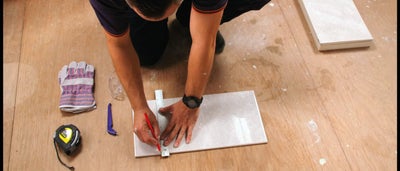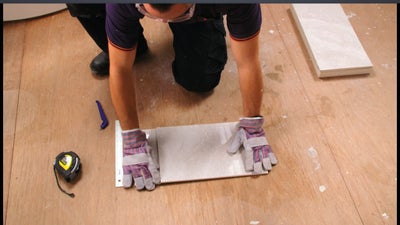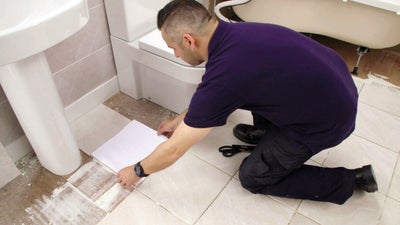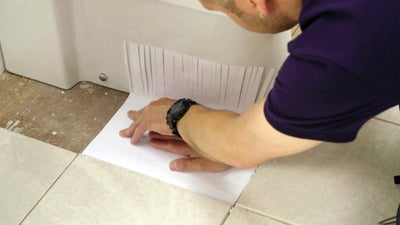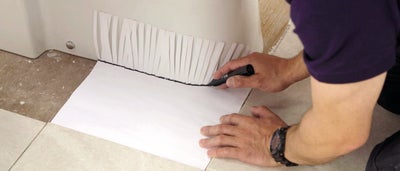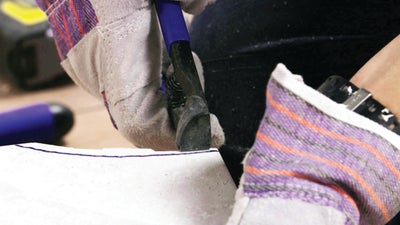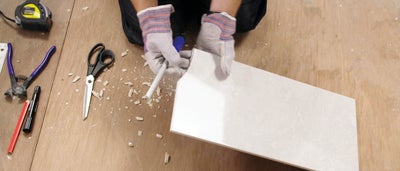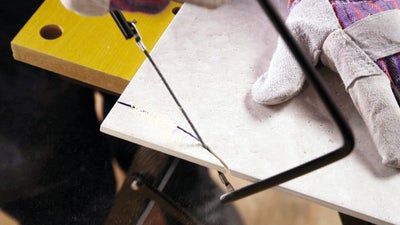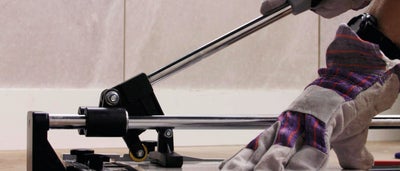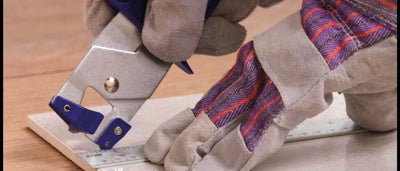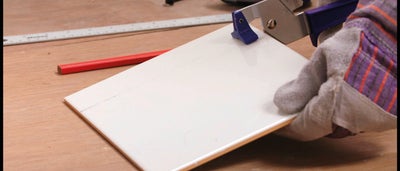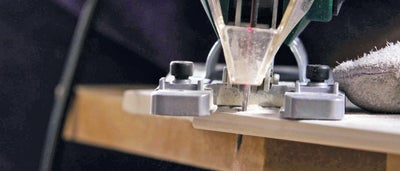Cutting tiles
Whenever you are tiling a wall or floor you will probably need to cut some of the tiles to fit around furniture, or an obstacle such as a toilet or a pipe.
Generating various tile shards and fragments is inevitable when cutting tiles. Because these shards can be very sharp, it’s always best to wear appropriate safety equipment such as safety goggles and protective gloves. Although they’re not essential we also recommend wearing kneepads too, as tiling often involves kneeling for long periods of time.
What is the best way to cut tiles?
The most suitable tools for cutting depends on the type of tile you’re working with. There are a number of tools for cutting ceramic tiles, which are usually less than 15mm thick. These include a tile scorer, a tile saw, or a tile cutting machine.
When cutting porcelain tiles, which are delicate and usually more than 15mm thick, a diamond blade wet-saw tile cutter is the best tool to use.
In kitchens and bathrooms you will probably need to cut curved tiles to fit around a toilet or sink. To cut curved lines it’s best to use a tile nipper or a special hacksaw. We cover all these options in the following guide.
How do I cut a tile without a tile cutter?
Depending on the type of cut you need to make, it’s possible to manually cut ceramic tiles. Scribing the tile is the simplest method – using a metal ruler and a pencil, mark your measurement onto a tile and draw a cutting line.
Firmly hold the metal ruler against the pencil mark and use a tile scriber to score the pencil line several times. Make sure the tile is scored along its full length to guarantee a clean edge.
Place your pencil directly underneath the scored line and press down firmly on the tile to split it.
How do I cut a curved tile?
The best way to cut a curved tile is with a tile nipper or a specially designed hacksaw.
Firstly, you will need to create a paper template of the necessary tile shape. Cut a piece of paper to the same size as a whole tile, then cut a series of 5-10mm wide slits along the edge where the paper tile touches the base of your obstacle.
Place the paper tile into position, allowing a 5mm gap for tile spacers. Form your edge against the obstacle by pressing the paper down and folding back the slits. Then use a pencil to mark the edge of the obstacle along your template. Remove the template and cut along the edge line.
Check that your paper tile is an accurate fit, then tape it to a real tile and carefully mark the intended cut line. Remove the paper and tape and use a tile scribe to score along the pencil line.
Use a tile nipper to cut away the unwanted part of the tile. Only remove small chunks at a time as you work your way towards the scribed edge. Take much smaller chunks when you get close to the line.
When you reach the scribed line, smooth off the edges using a tile file or fine grade sandpaper. Then wipe the tile with a damp cloth to remove any dust and fit the cut tile.
You can also use a hacksaw with a tungsten carbide rod to cut ceramic tiles. Securely hold the tile on a workbench and gently cut along your marked line, pulling the saw backwards and forwards. Smooth off the edges with a tile file or fine sandpaper and wipe down with a damp cloth.
How do I use a tile cutter?
Mark up the tile and insert it into the machine so that the mark is in line with the guide. Lower the handle to bring the scorer into contact with the tile and push or pull the handle to score once along the line.
Lower the handle fully so that the snapper touches the tile and apply pressure to snap the tile in two.
How do I use a combined tile scorer and snapper?
Score along your mark using the tile scorer and a metal ruler.
Insert the tile into the jaws of the tile snapper, aligning the scored mark to the centre of the tool. Squeeze the handles and the tile will snap in two.
How do I use a tile saw?
After marking your cut line with a pencil, use the tile saw on a workbench and choose a slow cutting speed. Turn the tile as you cut rather than turning the tool.
Smooth off the edges with a tile file or fine sandpaper and wipe down with a damp cloth.
How do I cut porcelain tiles?
Porcelain or natural tiles are more delicate than ceramic tiles, which makes them difficult to cut with a normal tile cutter. You will need to use a diamond blade wet-saw tile cutter. These can cut tiles up to 25mm thick and have a fine blade to prevent chipping.
Mark out your cutting line as usual and apply masking tape along the edge to reduce the chance of chipping. Align your guide mark with the blade then slowly and steadily feed the tile along the blade until the cut is made. Remember to keep the water topped up to prevent the blade from overheating.
